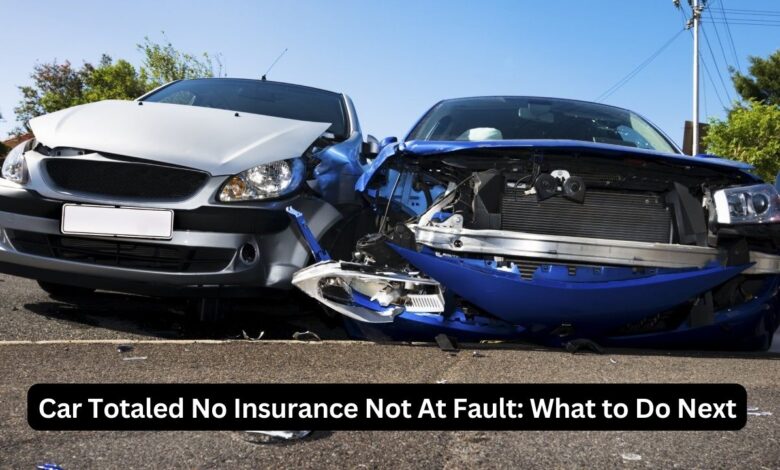Car Totaled No Insurance Not At Fault: What to Do Next

Understanding the Situation: Car Totaled No Insurance Not At Fault
Experiencing a car accident can be a harrowing event, especially when your car is totaled, and you don’t have insurance coverage. Adding to the complexity is the fact that you are not at fault. Navigating this situation requires a clear understanding of your rights, responsibilities, and the steps you need to take to ensure you are compensated fairly.
Immediate Steps to Take After the Accident
-
Ensure Safety and Seek Medical Attention
- Your health and safety should be the top priority. Immediately check for injuries and call emergency services if necessary.
- Document any injuries as they may be crucial for your claim.
-
Call the Police
- Reporting the accident to the police is essential. They will document the scene and create an official report, which will be vital for any claims or legal proceedings.
-
Gather Evidence
- Collect as much information as possible at the scene. This includes photos of the vehicles, the accident scene, and any visible injuries.
- Exchange information with the other driver, including their name, contact information, and insurance details.
- Get contact information from any witnesses.
Dealing with the At-Fault Driver’s Insurance
Since you are not at fault, the at-fault driver’s insurance should cover the damages. Here’s what you need to do:
-
File a Claim with the At-Fault Driver’s Insurance
- Contact the at-fault driver’s insurance company to file a claim. Provide them with all the necessary documentation, including the police report and any evidence you gathered.
-
Understand the Insurance Adjuster’s Role
- An insurance adjuster will be assigned to your case. They will assess the damage to your vehicle and determine the payout amount.
- Be honest and detailed when discussing the accident and damages with the adjuster.
-
Negotiate a Fair Settlement
- Insurance companies may initially offer a lower settlement. Be prepared to negotiate to ensure you receive fair compensation for your totaled vehicle and any medical expenses.
Legal Options if the At-Fault Driver is Uninsured or Underinsured
If the at-fault driver does not have sufficient insurance to cover your damages, you have a few options:
-
Sue the At-Fault Driver
- You can file a lawsuit against the at-fault driver to recover your losses. This process can be lengthy and costly, but it may be necessary to receive adequate compensation.
-
Check for Other Insurance Policies
- Sometimes, other insurance policies, like health insurance or personal injury protection (PIP), may cover some of your medical expenses.
-
Explore State Programs
- Some states have programs to help victims of uninsured or underinsured drivers. Research what assistance might be available in your state.
Financial and Legal Implications of Driving Without Insurance
Driving without insurance has significant consequences, even if you are not at fault for the accident. Understanding these implications can help you navigate the aftermath more effectively.
-
Fines and Penalties
- Most states impose fines and penalties for driving without insurance. These can include hefty fines, suspension of your driver’s license, and even impoundment of your vehicle.
-
Financial Responsibility
- Without insurance, you are personally responsible for any damages or injuries you cause in an accident. This can lead to substantial financial burdens.
-
Difficulty Obtaining Future Insurance
- Having a lapse in insurance coverage can make it more difficult and expensive to obtain insurance in the future.
Preventive Measures: Avoiding Future Issues
Taking proactive steps can help prevent similar situations in the future.
-
Maintain Continuous Insurance Coverage
- Ensure that you always have valid auto insurance coverage to avoid legal and financial complications.
-
Understand Your Insurance Policy
- Familiarize yourself with your insurance policy’s terms, coverage limits, and exclusions to ensure you have adequate protection.
-
Consider Uninsured/Underinsured Motorist Coverage
- Adding uninsured/underinsured motorist coverage to your policy can provide additional protection if you are involved in an accident with an uninsured or underinsured driver.
Conclusion
Navigating the complexities of a car accident where your car is totaled, and you have no insurance, but are not at fault, requires diligence and a clear understanding of your rights and options. By taking the appropriate steps immediately after the accident, dealing effectively with the at-fault driver’s insurance, and understanding your legal and financial responsibilities, you can ensure that you are compensated fairly and avoid similar situations in the future. Always remember the importance of maintaining adequate insurance coverage to protect yourself from unforeseen circumstances.